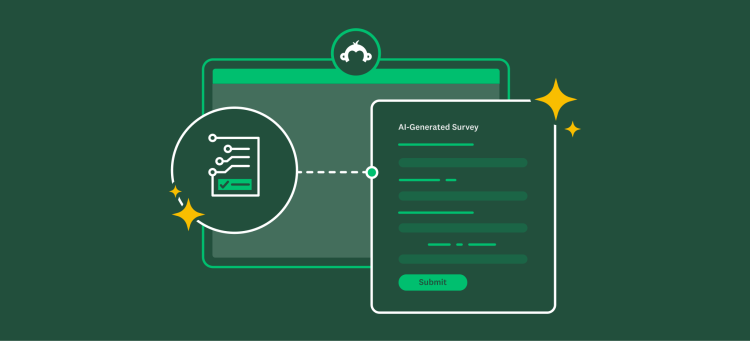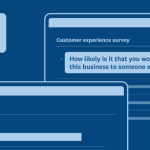According to HubSpot’s Flywheel marketing model (and most forward-thinking companies), marketers’ jobs don’t end when a customer signs the contract or hits “buy.”
Good marketing means that lines of communication between customers and the people who are writing messages for them are always open, and surveys are the easiest way to do that. If you aren’t listening to your customers, you won’t know how to win new ones—or keep the ones you have.
Surveys enable you to collect insights, stay top of mind for customers, and make them feel heard. You probably use customer satisfaction surveys in some capacity, but the world of customer surveys is much bigger than that.
We partnered with HubSpot to create a comprehensive end-to-end guide on them. Here are a few juicy Sparknotes.
Use survey data at every stage of the marketing flywheel.
Make data-driven decisions and delight your customers at every touchpoint. Here's how.
1.Create truly unique, newsworthy content with original research. They say content is king, and there’s one kind of content that makes an especially big impact: original research.
Eighty-two percent of people would rather read an article based on data than an op-ed, and unlike op-eds or even many how-to’s, original research studies are truly unique. Surveys are the easiest way to perform original research at scale.
Here are a few key ways to use original research-based content in marketing.
- Lead generation: Market research is always a valuable asset, so do the market research your customers would want to know. Selling to finance companies? Investigate consumers’ attitudes about investing. Healthcare? Find a topic relevant to that. You want something so inherently valuable, it’s worth filling out a form. And if that happens to be tangentially related to your product? It’ that much better.
- Brand awareness: Slow news cycle? Or just not that much media interest in general? The savviest content marketers use survey data to create original reports that help boost PR efforts, get media mentions, establish credibility, and ultimately increase their brand awareness.
- Site traffic: Backlinks and SEO are critical for content marketing success. Create data that gives context to a keyword of interest for high-ranking, helpful marketing pages.
Read the full guide to learn how to choose a topic, design a snappy survey, and recognize trends.
2. Take a tested, data-focused approach to new marketing campaigns. Imagine you want to run a new ad, change up your logo or packaging, or create a new brand name. If you test the concept before investing resources and pushing it out to the public, your odds of success go way up.
To get the best results from concept testing, you’ll want to programitize it and make the process as scientific as possible to get hyper-accurate results. Surveys can help you get input from consumers at scale, for a variety of different campaigns and a variety of different metrics.
This chart shows a few common metrics that you can use to assess each concept.

Read the full guide to learn how to design a scientifically sound concept testing survey, choose the right audience, and zero in on a winner.
3. Use surveys to deliver a tailored, delightful marketing event. Events—or “experiential marketing”—can give marketers a captive audience, which means they need to be captivating. Maintaining a healthy feedback cycle throughout the planning, execution, and event follow-up ensures that you deliver.
- Pre event: Pre-event surveys accomplish 2 things: clarify logistics (like learning about people’s arrival times or dietary restrictions) and tailor your event to attendee preferences. What topics would they like the speaker to cover? What’s their ideal start time? Which workshop would be the most interesting?
- During the event: Collect real-time feedback on the event, or do some market research with survey kiosks, tablets, or a QR code. This is your chance to get creative—offer a raffle or prize to anyone that fills out your survey, embed it into a presentation, or find other ways to make it an engaging and rewarding experience.
- Post-event: Get insight into how your event went so you can assess which aspects were a hit and which you might want to change next time.
Read the full guide to learn how to set up surveys for conferences, how to personalize and time them, and how to avoid the most common mistakes.
4. Measure customer satisfaction for tangible success metrics. You might know that you should be measuring customer satisfaction—and even using that as a marketing metric—but are you doing it right? Is your survey optimized for the best customer experience?
Here are some free templates from our guide to get you started.
Read the full guide to learn about the different types of NPS survey, how to time your customer satisfaction surveys, where to send them, and how to get the best bang for your buck.
5. Collect sound bytes and stats from your customers to tell your story better than your marketing language ever could. Need proof? SurveyMonkey research found 82% of people trust the voice of your customers over brand or product copy, and Nielsen research found 92% of buyers trust peers over advertisers.
Surveys are the perfect way to capture authentic customer stories without an elaborate ask for your customers. So how do you get the most value?
Here are a few tips on survey structuring from the guide.
- Reverse engineer your responses: This might seem obvious, but remember to ask about the specific features you’re most interested in highlighting. Think about your differentiators, and make sure they’re reflected in your survey.
- Optimize for striking stats: ask divisive questions that force people to take a stance (Which is your favorite feature X, Y, or Z?) and always make them multiple choice. Include enough options to give people a choice, but remember that every option you add dilutes your findings a little, so err on the side of fewer choices when you can .
- Include an open-ended question so you can collect individual quotes.
Read the full guide for strategies for getting customers on the record and ways to leverage customer stories in marketing materials.




